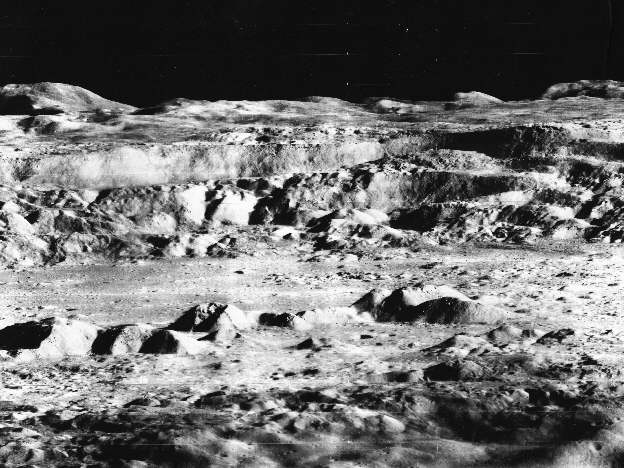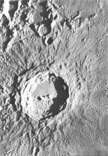
LO2-H162-3a
Medium-Res
(1.6
MB JPEG)
LO2-H162-3a Full-Res (9.8 MB JPEG)"On
first seeing this oblique view of the crater
Copernicus," declared Oran W. Nicks, Deputy
Associate Administrator, Office of Space Science
and Applications, NASA, "I was awed by the
sudden realization that this prominent lunar
feature I have often viewed by telescope is a
landscape of real mountains and valleys,
obviously fashioned by tremendous forces of
nature. It is no wonder that some writers
immediately classified it as the 'Picture of the
Year'! [Some, with understandable enthusiasm,
even hailed it as the 'Picture of the Century.']
"Lunar Orbiter II recorded this
image at 7:05 p.m. EST on November 24, 1966, from
28.4 miles above the Moon's surface, and about
150 miles due south of Copernicus. The clarity of
the view is attributable to the absence of
atmosphere. A photograph from similar altitudes
of distant features on Earth would never be as
sharp, because of haze.
"Copernicus is about 60 miles
across and 2 miles deep: 3000-foot cliffs,
apparently landslide scarps, can be seen. Peaks
near the center of the crater form a small
mountain range, about 1500-2000 feet high and 10
miles long.
"The Lunar Orbiter photography
was accomplished with two cameras," Nicks
explained, "one having a 3-inch focal length
and the other a 24-inch focal length. These
cameras were boresighted, so that each high-resolution
photo was always contained in a moderate-resolution
frame. Lunar Orbiter cameras were relatively
conventional film cameras that combined a Bimat
chemical development process with an electronic
scanning readout for transmission by radio to
Earth. The film images provided a very effective
method of storing information for transmission
bit by bit, at a modest rate."

"The telescopic view of
Copernicus shown above is one of the finest
photographs ever taken of this region from the
Earth, and shows features as small as 2500 feet
across," said William E. Brunk, Planetary
Astronomy Chief, Lunar and Planetary Programs
Directorate, NASA. "It is not possible to
photograph smaller features because of the
turbulence in the Earth's atmosphere.
"The crater Copernicus, a
prominent feature on the lunar landscape, is
believed to have resulted from an impact of a
second body with the Moon," Brunk continued.
"The 'keyhole'-shaped crater, Fauth, is seen
at the bottom of the photograph; the Carpathian
Mountains at the top. Characteristics of the
landscape are clearly shown by the shadows
produced by the rising Sun, whose elevation was
approximately 10 degrees above the horizon.
Numerous mounds are visible on the floor of
Copernicus, in addition to the central peaks."
Source: Orbiter II Takes the
"Picture of the Year"
EXPLORING SPACE WITH A
CAMERA
NASA SPS-168
|